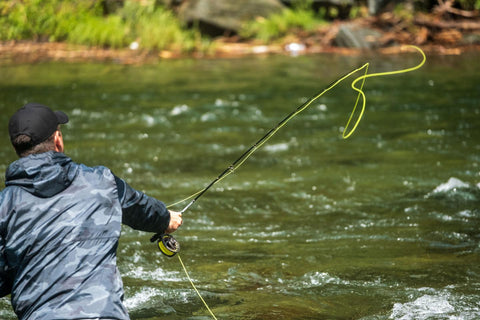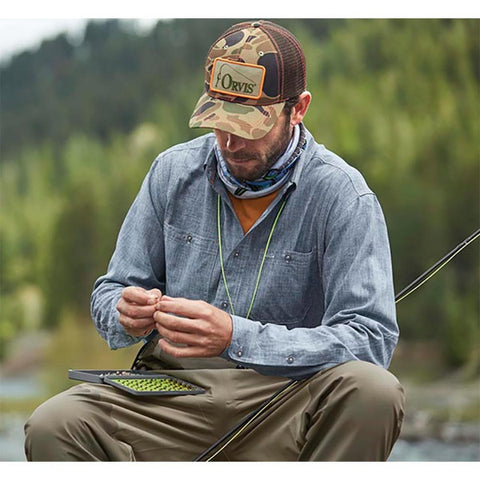
As you know, we here are Outdoor Equipped love to fish. Fishing brings out the quiet and romance of the outdoors in ways that other sports don’t. Not only does it give you an excuse to find beautiful places to park yourself, but it’s meditative and oriented around self-improvement. It can provide a tasty meal, and people have been fishing for food since the beginning of time.
What makes fly-fishing special is the depth to which it brings you into your environment. We’ll always have a place in our hearts for sticking a nightcrawler on the hook and casting for some channel cats, but lately we’ve been wading into fly-fishing, charmed by the feeling of being immersed in the environment. You get down into the water, if just a little bit; you can feel the cold coming off it. You perfect your cast, watching the ripples as the fly traces the water’s surface. You learn the behavior of a stream, how it interacts with the bottom and with trees hanging over it. You get a chance to really learn where fish like to hang out and take a rest, what to look for in the little eddies of the current.
River Fishing With Artificial Flies

In the grand scheme, fly-fishing is a relatively new method, tracing its origins to the Roman-era or the middle ages, depending on who you ask. Fishermen noted with frustration that the most prized river fish loved hunting for flying insects at the stream’s surface. Some of these insects could be used for bait, of course, but often they didn’t stay on the hook very well. Worse, there was a distinct way that fish hunted them: by their behavior - by sight, rather than their smell or touch. How to not just dangle a mayfly in the water on a hook, but to mimic its movements in a way that really enticed those sweet, sweet trout…
Early fly-fishers discovered that using a hook tied with small chicken feathers instead of live bait did the trick! The feathers flitted along the water’s surface, creating ripples that big fish would ferociously snap at. This knotty problem and its solution get at what makes fly-fishing different from regular bait fishing. After millennia catching fish in weirs, nets, and baited lines, the solution to mimicking flying insect behavior for fish led to a whole new way for people to fish. Instead of live bait on a weighted hook, dangling in the water for fish to find, fly-fishermen used very light artificial lures - flies - and a weighted line to cast that fly out and pull it along the water’s surface to create the telltale ripples and shadows that hunting fish look for.
Orvis Fly Rods Are Just the Beginning

In America, fly-fishing is popular everywhere, from the Pacific Northwest to the Great Lakes and the Gulf Coast. But the center for early fly-fishing was Vermont, and the epicenter was Manchester, where the American Museum of Fly Fishing still is today. City-dwellers flocked to the streams of the Green Mountains to get back to nature, and it’s here that Charles Orvis opened his store selling fishing tackle and accessories. But his primary customer base wasn’t just the people of Manchester, but the weekenders and summer vacationers who returned to their homes in far-off New York and Boston at season’s end. In a stroke of genius, he introduced a catalog to keep them on the hook during the off-season.
It worked like a charm. Not only did Orvis’s reputation for quality fly-fishing gear expand with the popularity of the sport, but Orvis itself became a nexus for a whole lifestyle. Not just fishermen but hikers and hunters were soon taking advantage of the company’s expanding line of high-quality gear and attire. The company kept one foot firmly planted in tradition, and the other searching for innovation. To this day, in addition to the high-strain graphite fiber rods that have opened fly-fishing to new territories and new target catches, Orvis still offers quality split-bamboo rods for the hardcore traditionalist. Their whole line beautifully combines the utility of well-made tools and clothes with the romance of the outdoors.
Men’s Canvas Jackets, Fishing Jackets, and Outdoor Sweatshirts

Vests are synonymous with the outdoors for good reason. Designed to cut the chill of the early morning or late autumn, vests keep your core warm while allowing superior freedom of movement than jackets. Orvis’s RT7 Quilted Vest is well-designed and versatile enough to be your trusty companion for a hike through the countryside and for an evening out on the town. It’s got side-vents for even more range of motion, and the front zips fully, with a snap-closed storm flap to keep out the wind. Diamond-quilted, it’s packed with just enough filling to keep you warm, without the puffiness of a lot of quilted vests. And in addition to its two zip-closed handwarmer pockets, it’s got an interior chest pocket that zips closed for secure stowage.

Adventure and worldliness pour out of every stitch of Orvis’s Pack-and-Go Jacket. The perfect wind- and water-resistant jacket to keep you dry whether you’re hiking the countryside or touring the city, the Pack-and-Go packs easily into its own travel sack, and pops out just as easily when you need it. Likewise, the jacket’s hood packs away into the collar. The whole thing is extremely quick-drying, lightweight, and designed for layering with the rest of your outfit. But despite its light weight, it still manages to make room for two interior zippered pockets for stowing valuables, as well as details like an internal drawcord to secure the whole thing tight around you. The fabric resists stains so you’ll always look good. Best of all, Orvis worked with the folks over at bluesign® to ensure that the whole process of making the jacket’s fabric is carried out in a way that’s safe for the environment, garment workers, and you.

Nothing says classic Vermont like Orvis’s Heritage Field Coat. The type of dry-waxed cotton canvas jacket that generations have turned to to protect from rain and thorn-bushes alike, the way Orvis’s updated field coat combines tradition with innovation is a perfect embodiment of the company’s philosophy. Designed with upland hunting in mind, it features a bellowed bi-swing back for expanded freedom of movement without bunching and gusseted underarm panels with grommets to provide ventilation. Shooting patches at the shoulders and reinforced patches at the elbows add strategic touches of durability where they might be needed. A storm flap handles blustery weather like it’s nothing, and the corduroy collar and adjustable button cuffs lend added protection. Best, it’s got tons of pocket space, with snap-closed lower bellows pockets for easy one-handed access to field supplies and personal effects, two interior pockets, and upper slash handwarmer pockets to boot. It even features a zip rear-entry lined waterproof game bag.
Work, Hiking, and Hunting Shirts and Pullovers

Orvis really thrives at the confluence of classic style and rugged durability. So it should be no surprise that we’re including their Tech Chambray Workshirt in this review. Constructed of lightweight, quick-drying mechanical stretch polyester triple-needle stitched tight to give sun protection exceeding UPF 30, this plaid work shirt features air holes at the underarms for extra ventilation during strenuous work. And it features the signature Orvis sunglasses cleaner patch at the hem when sweat gets on your shades.

For colder weather, Orvis’s Signature Sweatshirt is a great versatile quarter-zip layer for the trail. Well-knit from a cotton-polyester blend that’s warmer and faster-drying than cotton alone, it’s both durable and comfortable, great at cutting the cold wind. It’s the type of sweatshirt you depend on for years.
Windbreaker Pants and Women’s Convertible Pants

Speaking of easy movement, Orvis hasn’t neglected their pants line. Models like their Jackson Quick-Dry Stretch Pants reflect the premium that Orvis puts on keeping people comfortable outside. Ditch the jeans on your next hike; these pants are lighter, cooler, handle moisture way better, and have a little stretch in them for whatever the trail throws at you. A shorts version is also available, when the occasion calls for it. Or better yet, check out some of the convertible pants that Orvis makes, which either roll and button up to a shorter hem or, like the Orvis Guide Pants, feature the nifty ability to zip off into shorts. They’re particularly helpful for seasons and locales with cooler mornings that warm up into hot afternoons, and allow you to convert to shorts without bunched or rolled-up legs affecting your freedom of movement. And like the other models we’re discussing, they follow the theme of excellent moisture-wicking and drying.
Hunting Dog Collars, Car Seat Washable Dog Beds, and More

In addition to gear and clothing designed to get humans comfortable in the great outdoors, Orvis has an excellent and expanding line of products designed for our adventurous four-legged friends. We can’t tell if it’s the result of a whim or a deep thought process among their leadership, but either way, it’s brilliant. In addition to rugged, weatherproof leashes and collars, with reflective material woven right into the material so Fido’s easy to spot with a headlamp in the woods, you can find accessories like the Grip-Tight Quilted Microfiber Backseat Protector. Designed for outdoor-loving pooches who… don’t exactly clean themselves off before hopping in for a ride, Orvis’s backseat protectors all incorporate easy buckles and Grip-Tight mesh to hold them in place when your dog moves around or even burrows and scratches at them. They’ll keep fur, dirt, sand, and mud (and slobber) off your seats, and have seat belt slits so the bench is still useful for human passengers without removing it.
Fowl Hunting and Fly Fishing Lessons
In addition to designing and crafting gear and clothing for your outdoor adventures, Orvis offers a whole host of educational experiences for aspiring hunters and fly-fishers to hone their craft. Offered both remotely and on-location in beautiful spots ranging from Vermont (of course) to Key Largo and the Wise River in Montana, some of these courses can get really species-specific and advanced, so even if you’re a veteran you can pick up some skills from real professionals. So grab your gear, throw on some tough, comfortable clothing that loves nature as much as you do, and hit the stream (or trail, or campsite, or bonfire, or…)







